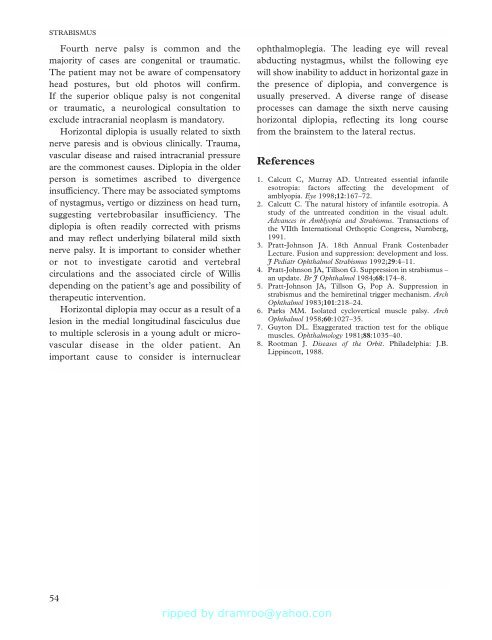Strabismus - Fundamentals of Clinical Ophthalmology.pdf
Strabismus - Fundamentals of Clinical Ophthalmology.pdf
Strabismus - Fundamentals of Clinical Ophthalmology.pdf
You also want an ePaper? Increase the reach of your titles
YUMPU automatically turns print PDFs into web optimized ePapers that Google loves.
STRABISMUS<br />
Fourth nerve palsy is common and the<br />
majority <strong>of</strong> cases are congenital or traumatic.<br />
The patient may not be aware <strong>of</strong> compensatory<br />
head postures, but old photos will confirm.<br />
If the superior oblique palsy is not congenital<br />
or traumatic, a neurological consultation to<br />
exclude intracranial neoplasm is mandatory.<br />
Horizontal diplopia is usually related to sixth<br />
nerve paresis and is obvious clinically. Trauma,<br />
vascular disease and raised intracranial pressure<br />
are the commonest causes. Diplopia in the older<br />
person is sometimes ascribed to divergence<br />
insufficiency. There may be associated symptoms<br />
<strong>of</strong> nystagmus, vertigo or dizziness on head turn,<br />
suggesting vertebrobasilar insufficiency. The<br />
diplopia is <strong>of</strong>ten readily corrected with prisms<br />
and may reflect underlying bilateral mild sixth<br />
nerve palsy. It is important to consider whether<br />
or not to investigate carotid and vertebral<br />
circulations and the associated circle <strong>of</strong> Willis<br />
depending on the patient’s age and possibility <strong>of</strong><br />
therapeutic intervention.<br />
Horizontal diplopia may occur as a result <strong>of</strong> a<br />
lesion in the medial longitudinal fasciculus due<br />
to multiple sclerosis in a young adult or microvascular<br />
disease in the older patient. An<br />
important cause to consider is internuclear<br />
ophthalmoplegia. The leading eye will reveal<br />
abducting nystagmus, whilst the following eye<br />
will show inability to adduct in horizontal gaze in<br />
the presence <strong>of</strong> diplopia, and convergence is<br />
usually preserved. A diverse range <strong>of</strong> disease<br />
processes can damage the sixth nerve causing<br />
horizontal diplopia, reflecting its long course<br />
from the brainstem to the lateral rectus.<br />
References<br />
1. Calcutt C, Murray AD. Untreated essential infantile<br />
esotropia: factors affecting the development <strong>of</strong><br />
amblyopia. Eye 1998;12:167–72.<br />
2. Calcutt C. The natural history <strong>of</strong> infantile esotropia. A<br />
study <strong>of</strong> the untreated condition in the visual adult.<br />
Advances in Amblyopia and <strong>Strabismus</strong>. Transactions <strong>of</strong><br />
the VIIth International Orthoptic Congress, Nurnberg,<br />
1991.<br />
3. Pratt-Johnson JA. 18th Annual Frank Costenbader<br />
Lecture. Fusion and suppression: development and loss.<br />
J Pediatr Ophthalmol <strong>Strabismus</strong> 1992;29:4–11.<br />
4. Pratt-Johnson JA, Tillson G. Suppression in strabismus –<br />
an update. Br J Ophthalmol 1984;68:174–8.<br />
5. Pratt-Johnson JA, Tillson G, Pop A. Suppression in<br />
strabismus and the hemiretinal trigger mechanism. Arch<br />
Ophthalmol 1983;101:218–24.<br />
6. Parks MM. Isolated cyclovertical muscle palsy. Arch<br />
Ophthalmol 1958;60:1027–35.<br />
7. Guyton DL. Exaggerated traction test for the oblique<br />
muscles. <strong>Ophthalmology</strong> 1981;88:1035–40.<br />
8. Rootman J. Diseases <strong>of</strong> the Orbit. Philadelphia: J.B.<br />
Lippincott, 1988.<br />
54










![SISTEM SENSORY [Compatibility Mode].pdf](https://img.yumpu.com/20667975/1/190x245/sistem-sensory-compatibility-modepdf.jpg?quality=85)





